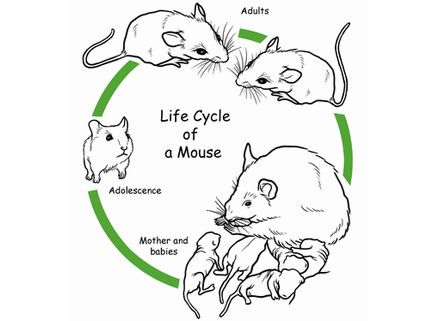
From birth to death we will cover everything you need to know about mouse biology. The duration of a life cycle of mice varies but in a case where it spends its time indoors it can live up to about three years before it dies naturally.
A single female is capable of producing up to eight litters per year with an average of six pups per litter.
What is the life cycle of a house mouse. House Mouse Life Cycle Reproduction. The house mouse is known for its ability to reproduce very quickly. A single female is capable of producing up to eight litters per year with an average of six pups per litter.
After a 21-day pregnancy these house mouse pups are born naked blind and dependent upon their mother for everything. Its not that the mouse lifespan is unnaturally long but more that mice are notorious breeders. Just one female mouse in your home can average between 25 and 60 offspring in a single year.
At that point you no longer have a mouse problem you have a mouse infestation. The typical mouse life cycle will vary but typically lasts about two years indoors which can be a problem for residents. Mice cause both damage and the spread of disease problems made much worse by their high birth rate.
On average an adult female mouse can have over 60 babies in one year. A pet mouse even well cared for wont typically live very long. The average house mouse lives between two and five years – in the wild life span averages 12 to 18 months.
In the wild a mouse is relatively small and defenseless and makes easy prey for predators like owls cats foxes and others. Commonly in females the estrous cycle lasts around four to five days and estrus itself lasts about 12 hours. A mouses estrous cycle is the changes in the animal brought on by reproductive hormones.
This is a sign of sexual maturity and is identified by bloody discharge or a period. Its a reliable indicator of potential mating among mice. This mouse blog post is all about the mouse life cycle.
From birth to death we will cover everything you need to know about mouse biology. Well talk about what they eat and their population numbers as well. If youre not sure how long a mouse lives.
A house mouse that you will typically see around your home can live anywhere from six months to around two years. Six months is closer to the average amount of time they live but if they have ideal living conditions including plenty of food water. House mice prefer cereals and seeds but they also eat vegetables fruits mushrooms roots meat etc.
During its life cycle a house mouse will have 7 or 8 litters each giving between 4 and 16 babies. They wont hesitate to invade your home to get an easy access to food and shelter. The life expectancy of a house mouse is 2 to 3 years maximum.
House mice are usually active at night. As its name suggests the house mouse thrives wherever there are people particularly in farm buildings warehouses sheds and garages although it is no longer a common resident of our homes. It eats grains seeds roots fungi and insects.
House mice construct a series of tunnels to live in. Females can have up to 10 litters a year of four. Learn about the life span and breeding patterns of mice.
For more information about the life cycle of a mouse and how it affects you visit Critter Control. Skip to Main Content. Once infestations of mice are established in homes they reproduce quite rapidly.
The duration of a life cycle of mice varies but in a case where it spends its time indoors it can live up to about three years before it dies naturally. However outdoor mice may live for a shorter period about 12 months on average. Below are a few lifespan averages for some of the most common mouse species in the Western United States.
House mouse Mus musculus 9-12 months Deer mice Peromyscus maniculatus 2-14 months White-footed mouse Peromyscus leucopus 12-24 months. The Lifespan of a House Mouse The average house mouse lives less than a year in the wild. Outdoors it can succumb to predators and starvation.
In a cozy indoor dwelling the lifespan of the house mouse is 1-2 years. House mice typically live for approximately two years or longer while outdoor mice usually only survive for about 12-18 months. This disparity in longevity is primarily a result of the improved shelter provided by human housing as well as the absence of predators and abundant food storage.
The figure below compares the life phases and maturational rates of mice and humans superimposed on a survival curve based on a large cohort of C57BL6J mice 150 males and 150 females. The maturational rate of mice does not linearly correlate with humansit occurs 150 times faster during the first month of life and 45 times faster over the next five months during which mice pass through. LCA is a holistic tool used to identify the environmental consequences of a product process or activity through its entire life cycle and to identify opportunities for achieving environmental improvements.
Life cycle stages include. Raw materials acquisition Manufacturing Usereuse. Most mice species have a very short life expectancy in the wild up to a year with the exception of the dormouse which can live for up to five years.
This is rivalled only by the edible dormouse that can live for up to nine years.